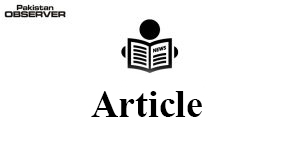Prof Abdul Shakoor Shah
PAKISTAN is a linguistically diverse country with around 74 languages. According to the 1973 Constitution, Urdu is the national language, while English is the official language of Pakistan. The constitution further states that the said status will continue till the planning is finalised to be replaced by Urdu. Today, almost 47 years after the Constitutional promulgation, the situation on the ground is the same as it was 47 year before. The Constitution also recognizes the range of regional/provincial languages in vague terms. Nearly half of all Pakistanis 48 % speak Punjabi, 12 % Sindhi, the Punjabi variant Saraiki 10%, Pakhtu or Pashto 8 %, Balochi 3%, Hindko 2 %, and Brahui 1 %. Native speakers of other languages, including English, Burushaski, and various other tongues account for 8% to 10%. At least 7,457 languages are spoken across the globe, of which 360 are not spoken anymore. The English-Urdu divide in Pakistan is leading Urdu towards extinction.
English-Urdu holds ‘linguistic capital’ in Pakistan’s linguistic marketplace. The use of Urdu as a lingua franca is prevalent across the country. However, English dishes up as the official language and the language of the more fortunate cream of the crop institutions. Hence obviously, English plays the role of concierge for ingress into celebrated higher education institutions and highly paid jobs. The vitality of instructing regional languages in addition to English and Urdu is documented by Pakistan’s National Education Policy. But regional languages are at the subordinate level of the language pecking order and are used mainly for informal communication.
Academically, however, linguistic segregation is vivid in the two-stream system, referred to as Urdu and English medium. Urdu medium schools are generally the state schools of the poor people while the English mediums are private fee-paying schools for the financially well-off strata. This discrepancy in the educational system has alienated the nation into an identity crisis of self and others endorsed by the government policies and related practices. Normally, the high-income schools follow the Cambridge system (O/A level track), while the medium to low-income private and state-owned Urdu-medium schools follow the local/provincial system of examinations (matriculation/intermediate track). Also, there are a few Sindhi-medium state schools in the Sindh province. In higher education, English is the medium of instruction in all prestigious Higher Education Institutions However; both English and Urdu are used as medium of instruction in some departments in the public sector.
The fact of the matter is that English, being the language of the high ups and higher education in Pakistan, is considered the language of personal and professional development. Often, English acts as a way in for being a compulsory subject in entrance exams for higher education institutions as well as those leading to the stratum of power such as the civil services of Pakistan. The researchers argue that Pakistan’s shaky parallel education systems, are mainly marked by an evident dissection in the medium of instruction and communication; The very high fee structure of the privileged English-medium schools and private universities generates obstacles for children from the middle and lower classes to partake in the educational opportunities offered by these institutions. As a result, non-elite or low-fee English medium schools have burgeoned in the last two decades.
The English-Urdu divide is also submerging the nation into identity deluge. The institutional or I-identity which is imposed upon by institutions and institutional policies and practices, is hindering the way of majority of low middle class youths to partake in national development. A-identity based on one’s affiliation with a well-recognized group of people which is resulting in discrimination in the society. Language works like force. Every time language learners speak, they are not only swapping over information with their interlocutors; they are also persistently shaping and reshaping a sense of who they are and how they relate to the social world. These identities can also be seen as being prejudiced by linguistic capital, referring to the linguistic chattels possessed by individuals and passed on through informal and formal networks that determine the progress they can make in life. Linguistic capital can be seen as a decisive facet of the identities of learners in educational institutions particularly in the context of Pakistan where the English and Urdu medium divide extends from families and informal interaction into more formal learning systems.
English is conceptualized as a high value asset in the academic sphere and for future livelihood scenario and Urdu, for daring a higher social status within close and extended family. Learners’ Linguistics proficiency is either school or inherited based. The opportunities for attending certain school types with their associated characteristics, counting their medium of instruction, have an important penalty for learners’ identical insights. The English-Urdu medium divide is found in bigoted institutional policies and practices in the university context also. The learners who are less competent users of English struggle to build their identity in relation to their bilingual and other skills. We should step ahead to make policies and start resistance to get rid of these discrepancies and inequalities to hew out our nation from identity crisis, further splits and prejudices. There should be a single system of education. Curriculum should be innovative and studies must be conceptual rather than cramming. The linguists and policy makers should put collective efforts in this regard.
—The writer, an English language Professor, is based in Lahore.










